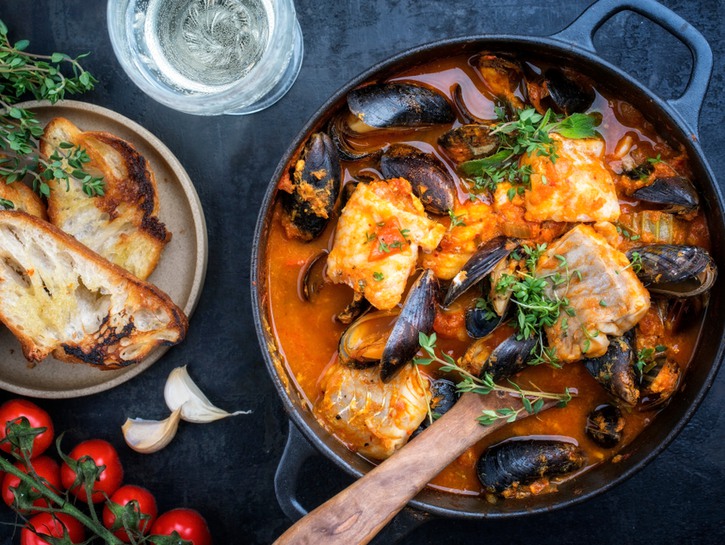Aren’t They One In The Same?
Louisiana is known for a lot of things — Mardi Gras, jazz, blues, drive-thru daiquiri shops, and the food, we can’t forget about the food. But more times than not, people outside and within the state will throw around terms like Cajun and Creole haphazardly and will even make the mistake of using the two terms interchangeably. To people like my ancestors (who were Creole but preferred to be called French), that’s a mortal sin.
The Creole and Cajun cultures, while comparable, are two distinct cultures with differing histories and differing culinary philosophies. And while both cultures are known for their gumbos, jambalayas, and a myriad of other famous dishes, they aren’t the same.
As the Louisiana Travel Authority put it: “A vastly simplified way to describe the two cuisines is to deem Creole cuisine as ‘city food’ while Cajun cuisine is often referred to as ‘country food.'”
We’ll spend the next little while expanding on that simplification to help you better understand the differences (and similarities) between Cajun and Creole culture and cuisine. And yes, it’s more than just the culture’s differing opinions on incorporating tomatoes in their dishes.

Cajun Food
The term “Cajun” is often used to describe just about anything coming from Louisiana. Whether it’s food, people, music, art, or any other piece of culture from the “Boot State,” a lot of people will call it Cajun. While that may be true for a portion of the state, the term should only refer to a certain portion of the population. So, what is it?
What Does “Cajun” Mean?
The term “Cajun” is drawn from the term “les Acadians,” the term that was used to describe the French colonists who were kicked out of the Acadia region of Canada (present-day Nova Scotia) during the French and Indian War in the 18th century.
When they left, the Acadians settled in four different regions of southern Louisiana — bayous, prairies, swamplands, and coastal marshes — an area now known as Acadiana. Upon setting in those areas of the state, the Acadians (now referred to as Cajuns) became quite resourceful as they made use of any type of vegetation and game they could find. Over the years, the Cajuns began to incorporate elements of Native American, German, French, and Italian cultures into their lifestyle and culinary efforts.
What Is Cajun Food?
As the Cajuns became more situated in Acadiana, they began to develop the distinct style of food we know as Cajun food.
One of the staples of Cajun food is sausage made from any number of animals. Refrigeration wasn’t really a thing back in the 18th and early 19th centuries, or at least not to the Cajuns, so smoking sausage to preserve their food supply was the way to go. Through those methods, the Cajun diet relied heavily on sausages like Andouille and my personal favorite, Boudin. This Cajun staple is made up of pork meat, rice, and seasoning that is then stuffed into a casing.
Gumbo, the unofficial signature dish of Louisiana, is also a major aspect of Cajun cooking and includes the “holy trinity of Cajun cuisine,” a base of onion, celery, and bell pepper. Dishes like Jambalaya, étouffée, and pretty much everything else are started with a healthy layer of those three important vegetables.
Cajun Dishes To Try
- Gumbo
- Crawfish or Shrimp Étouffée
- “Brown” Jambalaya
- Boudin or Boudin Balls
- Po Boys
- Meat Pies
- Fried Alligator
- Maque Choux
- Pain Perdu
- Crawfish or Shrimp Boils

Creole Cuisine
While the Cajun culture is more spread out across the southern portion of Louisiana, the Creole culture really got its start in and around the city of New Orleans. The term “Creole” refers to the descendants of the French and Spanish colonists who rose to prominence in New Orleans. Remember how we said Cajun was more country and Creole was more city? This is what we meant by that.
What Does “Creole” Mean?
It’s quite fitting that the term “Creole” has more than one meaning. While it can refer to the descendants of French colonists who made New Orleans their home, it can also refer to the mixing of multiple cultures, and is often used to describe the combination of European with African cultures as seen in the Caribbean.
As the distinct cultures from France and Spain mixed with with African and Native American cultures, Louisiana became a “melting pot” so to speak, and with that came the “Creole” culture many Louisianans — and millions of tourists — know today.
What Is Creole Cuisine?
Though similar to the fare found in Cajun culture, Creole cuisine — like the upperclass descendants of French and Spanish colonists — is considered a little more high brow than its more rural counterpart.
Remember how Cajuns only had access to the local vegetables and game that was within reach? Well, it’s the opposite for the Creole chefs. Due to having easy access to trade ships coming into New Orleans on a daily basis, Creoles could easily get their hands on exotic ingredients and even tomatoes. This is the reason Creole jambalaya contains tomatoes unlike its Cajun counterpart.
Creole Dishes To Try
- Gumbo
- “Red” Jambalaya
- Shrimp Linguine
- Red Beans And Rice With Fried Eggs
- Creole Shrimp
- Turkey An Andouille Sausage Gumbo
- Chicken Creole
- Shrimp Remoulade
- Bisque
- King Cake

Is One Better Than The Other?
There’s only one mistake you can make when trying to decide whether to eat Cajun or Creole cuisine — not eating both.
I’m sure there are people who will say that the Cajun gumbo from some shack in Acadiana is better than any Creole version in the Big Easy and vice versa. No matter where you find yourself, it’s all good as long as you don’t burn the roux.
